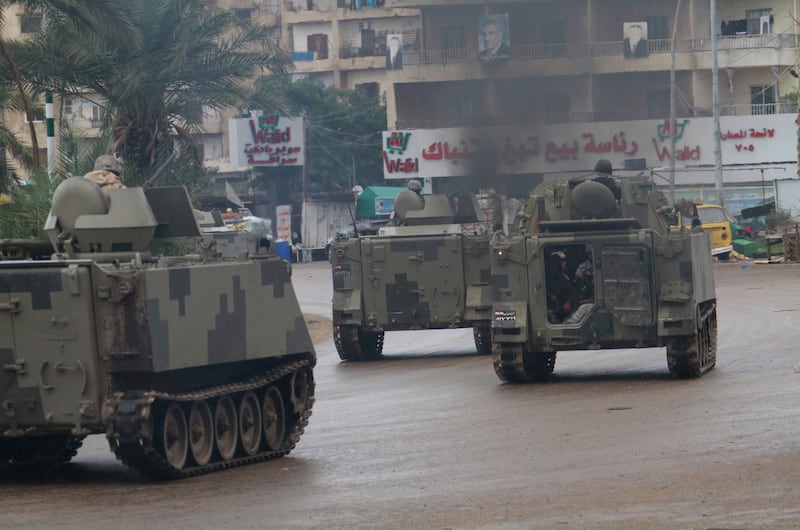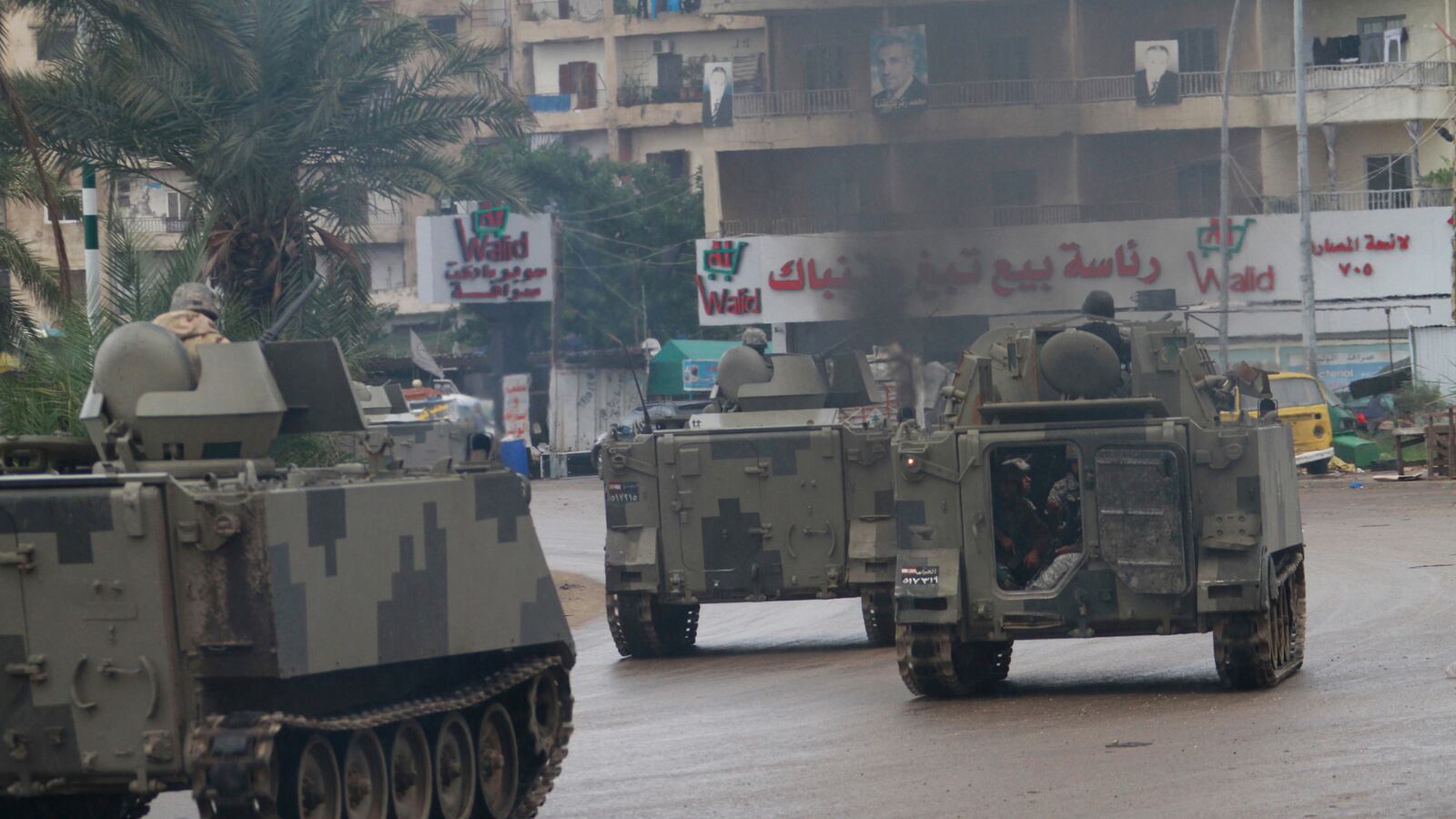The Lebanese Army deployed reinforcements Friday morning in the port city of Tripoli following a night of heavy armed clashes between gunmen loyal to opposing sides in neighboring Syria’s civil war, but with 13 dead and more than 60 wounded so far there are fears that the fighting risks dragging Lebanon into the mayhem of Syria’s sectarian conflict.

What’s more, no one is suggesting that the clashes have yet reached a tipping point. The government in Beirut has struggled for months to try to limit the repercussions on the country from the vicious warfare raging in Syria and to avoid the that country’s conflict reviving the Lebanese civil war of 1975 to 1990—a crisis that left 120,000 Lebanese dead and a quarter of the population wounded. But one government minister, Faisal Karami, acknowledged that the situation in north Lebanon is becoming “very critical and dangerous.”
The Lebanese Army has moved quickly in the past to put a dampener on clashes between Sunni gunmen loyal to the Syrian rebels and pro-Assad Alawites or Shiites in Tripoli and elsewhere in northern Lebanon. This is the seventh round of fighting between the sectarian communities in the coastal city since the uprising against Assad began 20 months ago and, in October, the army managed speedily to impose order when sectarian clashes erupted in Tripoli and Beirut following the assassination of Lebanese security boss Brig. Gen. Wissan al-Hassan. Many Lebanese suspect Hassan was killed on the orders of Assad.
In Tripoli this week, the Army has struggled to keep the warring groups apart. Intermittent clashes have rocked the city for four days, triggered when 21 Lebanese Salafists from the militant group Fatah al-Islam—a group linked with al Qaeda—were killed in an ambush by Syrian soldiers in the Syrian town of Tal Kalakh near Homs. The Salafists were on their way to joining a rebel unit in Syria.
Thursday night’s fighting in the Tripoli neighborhoods of Jabal Mohsen, an Alawite district that strongly supports Assad’s Alawite-minority regime in Syria, and Bab al-Tabbaneh, where Sunni residents oppose the embattled Syrian leader, came despite a heavy Lebanese Army presence with the military sealing off major roads and mounting checkpoints between the adjacent neighborhoods that have had a long history of conflict that stretches back to the 1975 Lebanese civil war.
There were no signs Friday morning that the sectarian violence involving rocket-propelled grenades as well as exchanges of mortar and machine-gun fire is any closer to ending despite the arrival of Army reinforcements.
Before this week of fighting in Tripoli, rival local leaders told The Daily Beast that there was little chance that further spillover from Syria’s civil war could be prevented. They acknowledged they were heavily involved already in the conflict across the border, supplying fighters and intelligence information as well as in the case of the Sunnis weapons to the rebels. They said Tripoli was serving increasingly in a similar logistical role in the Syrian conflict as the Pakistani border town of Peshawar did in the 1980s during the mujahedeen’s insurgency against the Soviet occupation of Afghanistan.
“We provide every kind of support we can to the Syrian rebels,” said Sheik Shadi Jebara, a Salafi leader in Bab al-Tabbaneh. “Why shouldn’t we? There are family and blood ties and kinship that cross the border. Many of us have Syrian wives and then we have a religious bond because we are Sunni. The war there is our war too,” he said.
According to Sheik Shadi “more than 200 fighters” from Tripoli have crossed the border to fight Assad—20 to 30 of which are from his own rundown district of Bab al-Tabbaneh. “We supply any arms we can get for the Syrian rebels, mainly AK-47s and RPGs.”
Sitting outside the small bakery he owns in the heart of Bab al-Tabbaneh as Lebanese army personnel carriers warily patrolled nearby streets, he said Syrian rebels from the Free Syrian Army had urged Sunnis in Tripoli to secure bigger weaponry and that recently they had managed to “buy some Grad rockets” on the black market. Surface-to-air missiles, a top priority for the rebels to combat Assad’s warplanes and gunships, had proved elusive, he said.
For his part, Ali Mohammed Fadlallah, a spokesman for the predominantly Alawi Arab Democratic Party, blamed the fighting in Tripoli on an “increasing presence of foreign Jihadists and Salafists in Lebanon,” a consequence of the civil war in Syria, which he said was attracting foreign fighters to Lebanon.
Speaking in the heavily guarded party headquarters in Jabal Mohsen, about half-a-mile away from Sheikh Shadi’s bakery, he argued that the Free Syrian Army was infiltrating northern Lebanon. “The FSA reminds me of the PLO during our civil war. History is repeating itself. The FSA is getting more powerful in Lebanon. It is not as big as the PLO yet but it has the potential to grow here and become more influential and destructive.”
Ominously, Sunni leaders in Tripoli decided this week to appoint Husam Sabbagh, a fighter who says he draws his inspiration from al Qaeda, as their military commander in the city. Sabbagh led Fatah al-Islam fighters when they clashed in 2007 with the Lebanese army at a Palestinian refugee camp and he has been a fugitive ever since.
As the clashes in Tripoli stoked sectarian tensions across Lebanon, former prime Minister Saad Hariri blamed the Hizbullah-dominated government of Najib Mikati for the worsening security situation inside its borders, criticizing it for not deploying the Lebanese Army along the country’s borders with Syria to prevent arms smuggling and to prevent gunmen crossing to and from Syria.
According to Hariri, much of the blame lies with Lebanon’s militant Shiite movement, Hizbullah, for the mounting risk of Lebanon being sucked further into the Syrian conflict. Hizbullah has in recent weeks increased its support of Assad and mounted more excursions across the border to fight Syrian rebels. “Sending fighters to fight alongside the Syrian Army” has prompted some young men in Lebanon to join the rebels in Syria.





